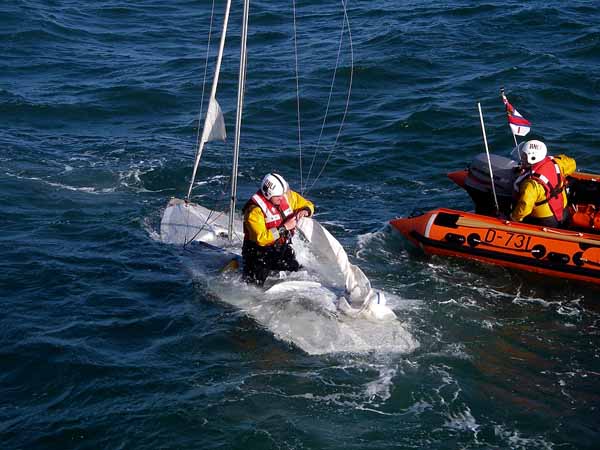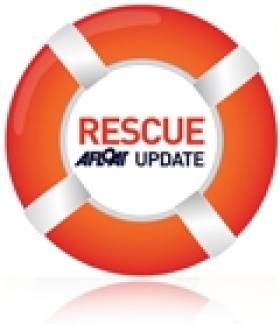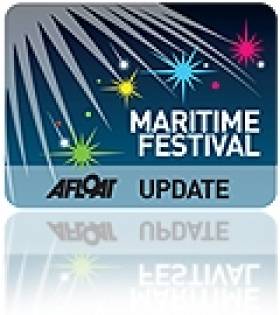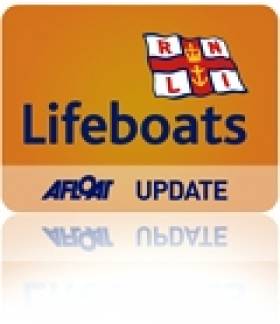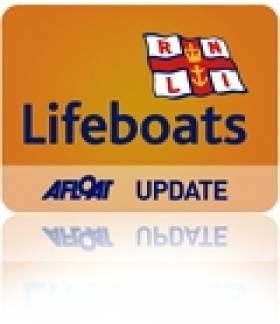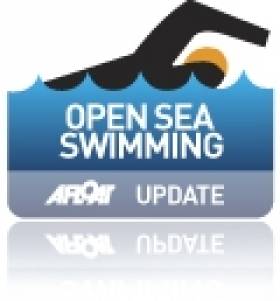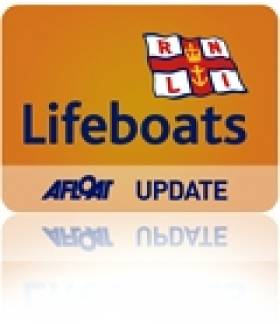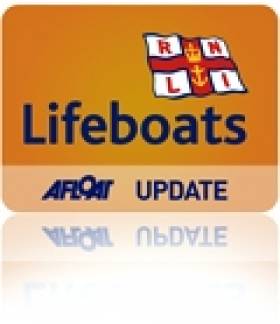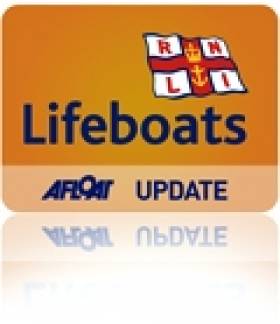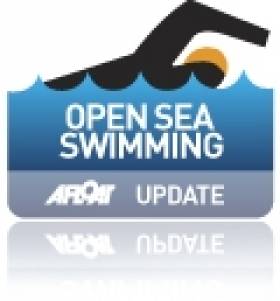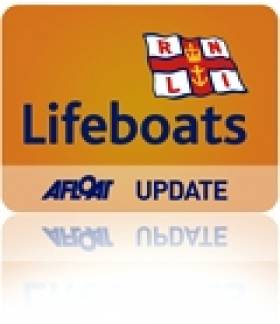Displaying items by tag: Lifeboats
Search Resumes for Donegal Fisherman
The search continues for one of the two-man crew of a Donegal lobster boat that sank off the Inishowen peninsula yesterday morning.
The Irish Times reports that the body of 65-year-old Edward Doherty was recovered from the sea yesterday. His nephew, 41-year-old Robert McLaughlin, was still missing last night when the search was suspended due to bad weather.
The pair's vessel, the 26ft Jennifer, was retrieved by divers south of Malin Head, close to Glengad pier.
In a tragic mirror of the weekend's rescue of two young fishermen off the Co Mayo coast, it's believed that Doherty and McLaughlin had similarly cast off to check on pots.
Malin Head marine rescue centre dispatched the Irish Coast Guard's Sligo-based Sikorsky search-and-rescue helicopter and the RNLI's Lough Swilly and Portrush all-weather lifeboats when the alarm was raised early yesterday.
Some 20 local vessels also joined the search, though they were impeded by heavy rain and choppy seas.
The Marine Casualty Investigation Board is expected to investigate the incident, which is the second in the area in less than three years.
The Irish Times has more on the story HERE.
Sea Songs and Shanties Make a Winning Combination
A wonderful weekend of maritime celebration took place in Rosses Point in August. It was the inaugural festival of Shanty and Seafaring organised by a local committee. The event took place over three days in the in the village which is steeped in seafaring history. As well as the singing readings and poetry, traditional Rosses Point events such as the "Go as you Please" and "Maugherow Cup" were hotly contested.
Many people from the village who lost their lives at sea were remembered in a special Mass and wreath laying ceremony at the "waiting on the shore" monument.
The total amount raised over the weekend through bucket collections, bbqs, and purchase of a specially commissioned CD by the local group Ashore for a Loaf, was a staggering €4434.00.
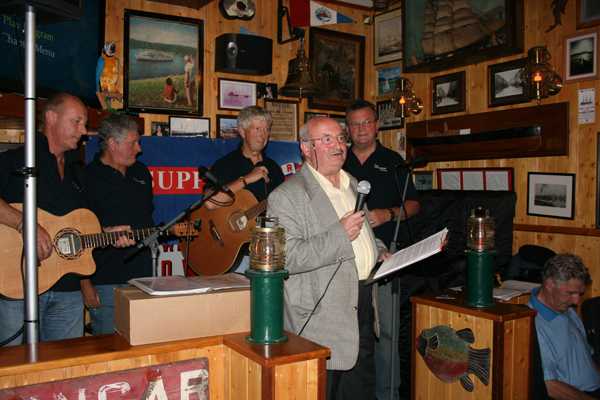
The Liverpool crew
The cheque was presented to the RNLI fundraising Chairman Pat Carter by Ann Mannion on behalf of the Shanty Festival Committee.In accepting the cheque Pat Carter congratulated the Shanty committee on a wonderful event and thanked them for their most generous donation to the RNLI. Pat Carter went onto thank the local people who as ever give very generously the RNLI Sligo Bay. The RNLI lifeboat service is funded entirely through voluntary donations.
The Committee have just announced that they will be holding an even bigger and better Shanty & Seafaring Festival in mid June 2011
Howth Lifeboat Rescues Drowning Woman
The Lifeboat crew had been out on exercise when they spotted the 31 year old female struggling above the waves. She had sunk two feet beneath the water when the crew reached her. They managed to catch her clothing and pull her aboard the All Weather Lifeboat (ALB), immediately administering first aid.
The RNLI crew then took the lady safely to Howth harbour, as she was thought to be too distressed to be lifted by the Coastguard helicopter which was also in attendance. An awaiting ambulance brought her to Beaumont Hospital to recover.
Howth RNLI voluntary crewmember Dave Howard says:
"All the crew were relieved that this rescue had a positive ending, the lady would certainly have died had we not already been at sea on exercise. She was very lucky"
Related Safety posts
RNLI Lifeboats in Ireland
Safety News
Rescue News from RNLI Lifeboats in Ireland
Coast Guard News from Ireland
Water Safety News from Ireland
Marine Casualty Investigation Board News
Marine Warnings
Enniskillen and Baltimore Busiest Irish Lifeboats, Launching Five Times a Day in Summer
Preliminary figures* for summer 2010, issued today (22 September) by the Royal National Lifeboat Institution (RNLI), show the charity's Irish lifeboats launched on average five times every day during June, July and August.
RNLI lifeboats were requested to launch 450 times during June, July and August. The busiest station in Ireland was Enniskillen in Fermanagh with 29 launches followed by Baltimore in West Cork with 23 callouts. Fifty-four of those launches were in Dublin at lifeboat stations in Dun Laoghaire (22), Howth (20) and Skerries (12). Read more about the year's lifeboat rescues in 2010 HERE
The figures come on the back of a significant investment by the charity in the Irish lifeboat fleet. New inshore lifeboats have been put on service in Dun Laoghaire, Kilrush in Clare and Fenit in Kerry. These new lifeboats are fast, efficient and technically equipped to reach casualties faster and to provide increased cover around the coast.
Commenting on the RNLI summer lifeboat launches, RNLI Training Divisional Inspector, Owen Medland, said, 'It has been a busy Summer for Irish lifeboat crews. Over the course of those three months there have been a number of dramatic and challenging callouts for our volunteers. This summer RNLI Sea Safety volunteers have run a number of lifejacket clinics and flare demonstrations around the coast and at inland waterways to advise all water users on how to stay safe on the water.'
RNLI Operations Director, Michael Vlasto, added: 'The summer is always busy as more and more people opt to relax at the coast. The figures show that our volunteers are called on much more during this time and the fact they respond every time the pager goes off shows just how committed they are to saving lives at sea.
'Many of our lifeboat volunteers are also particularly busy at this time with their day jobs as many of them work in the tourism industry, so we are especially grateful to them in summer – and to their employers who allow them to stop work at the "bleep of a pager" to help others, and given the current economic climate for businesses this is a great contribution to the charity.'
Read more about the year's lifeboat rescues in 2010 HERE
Related Safety posts
RNLI Lifeboats in Ireland
Safety News
Rescue News from RNLI Lifeboats in Ireland
Coast Guard News from Ireland
Water Safety News from Ireland
Marine Casualty Investigation Board News
Marine Warnings
Swim from Ballycastle to Rathlin Island Completed
Local French teacher Gary Knox has completed his swim from Rathlin to Ballycastle for Portrush Lifeboat Station on the very day that the station was celebrating its 150th Anniversary.
Gerry Doran Chairman of the Ballycastle Fundraising Branch texted the station at the start of the race and then at the end to confirm that Gary had completed his amazing feat!
This information was then relayed to the people who had gathered in Portrush for the Service of Thanksgiving and Vellum presentation.
Shelley Pinkerton, Chairman of the Portrush Fundraising Branch said
'This is an example of the innovative ways that people come up with to raise funds for the RNLI. It's very fitting that Gary completed the swim on the very day we are gathered to celebrate Portrush Lifeboat Station 150 years of saving lives at sea'
Gary who was not wearing wetsuit swam approximately 7 miles in 2 hours 55 minutes. The swim was for the RNLI and in memory of his friend and training partner, Ciaran McGinn who completed the endurance swim in 2007 and raised funds for his charity, Ballycastle RNLI.
Gary was accompanied by Portrush kayakers who followed the rib and provided him with energy drink every hour. In accordance with ILDSA rules, Gary was not permitted to touch the boat or kayak. Donations can still be made online at justgiving.com/gary-knox and there are collection boxes in the shops along the prom in Ballycastle.
Gary would like to thank Alan Wilson of Aquasports for providing boat cover, John Morton for advice and guidance, members of the Ballycastle Fundraising Branch and others for their assistance in organising the event.
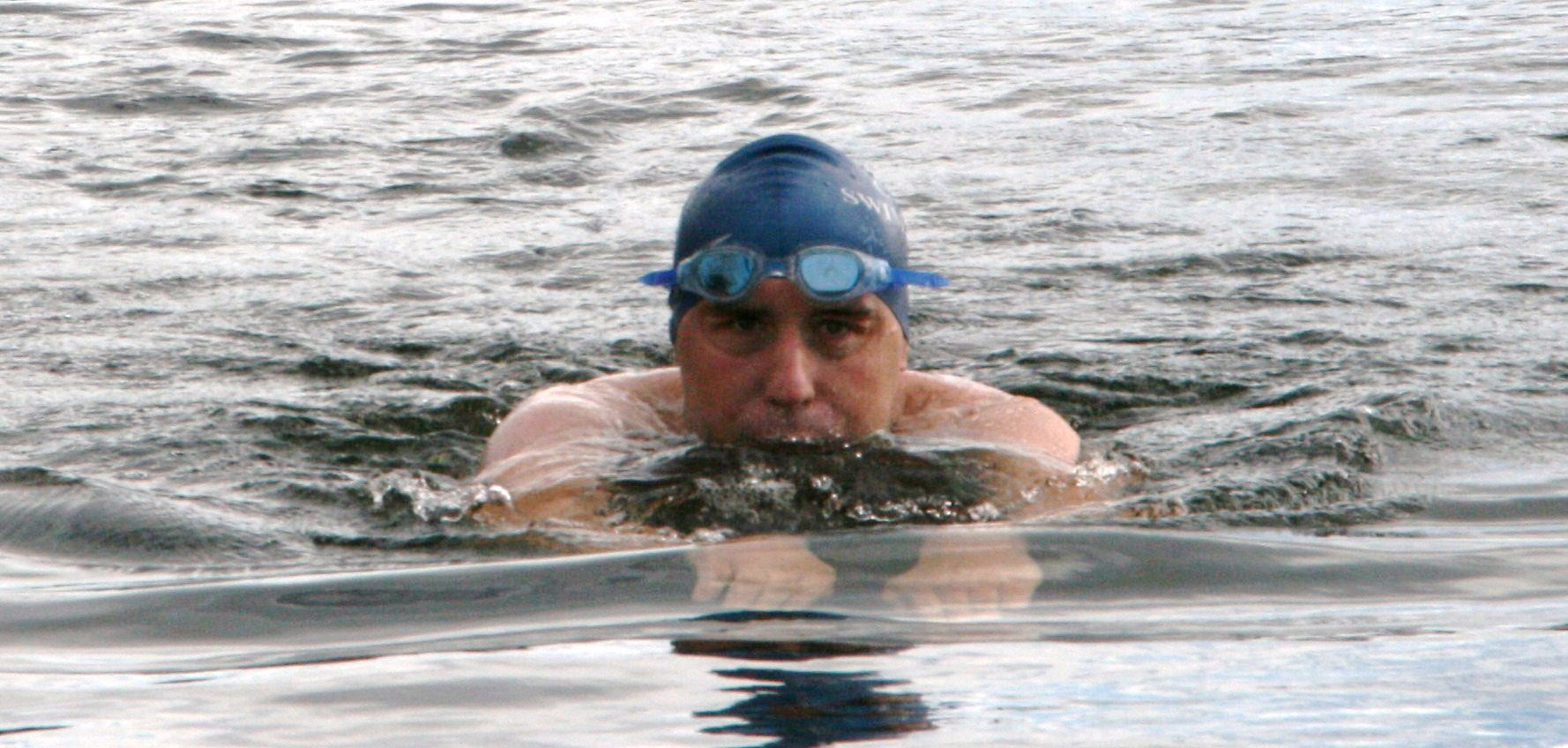
Gary nears the finish line
Lifeboat Assists Vessel with Engine Failure on Lough Derg
At 7.30pm tonight Lough RNLI Derg lifeboat towed a vessel to safety after it suffered engine failure. 15 minutes earlier the lifeboat was requested to launch to assist three persons in distress on board the 38ft motor cruiser. The lifeboat with helm Peter Clarke, Eleanor Hooker and Colin Knight on board, launched with into winds west north-west, Force 5, gusting 6 with rough seas. Visibility was initially good with fading light.
The lifeboat located the vessel in Youghal Bay, close to Ryan's Point, and was alongside at 19.35hrs. All passengers were safe and unharmed. They were wearing their lifejackets. The vessel had dropped anchor to prevent being itself being grounded, but the anchor was not holding and the vessel was rolling side-on to steep waves. Once a tow was set up, an RNLI crew member weighed anchor and the vessel and her passengers were taken to the safety of the public harbour in Garrykennedy.
The lifeboat returned to station and was ready for service again at 20.30hrs
Related Safety posts
RNLI Lifeboats in Ireland
Safety News
Rescue News from RNLI Lifeboats in Ireland
Coast Guard News from Ireland
Water Safety News from Ireland
Marine Casualty Investigation Board News
Marine Warnings
1720 with Broken Forestay Required Baltimore Lifeboat
A yacht suffering equipment damage and in danger of being dismasted prompted a call for assistance to the RNLI today.
The Schull based 1720 sportsboat had been participating in the Irish 1720 National Championships being run out of Baltimore Sailing Club, when the forestay snapped. According to the RNLI 'The boat with 5 persons onboard was in serious peril as the forestay is part of the rigging that holds the mast in place'.
Weather conditions at the time were challenging in the exposed waters near the Calf Islands in West Cork with force 5-6 winds and a 1.5 metre swell.
A race support boat held the stricken yacht head to wind, while the inshore lifeboat under the command of Kieran Collins made its way to the scene. The lifeboat crew of Ronan Sheehy and Micheal Cottrell then took the 1720 under tow and returned her to the safety of Schull Harbour.
Related Safety posts
RNLI Lifeboats in Ireland
Safety News
Rescue News from RNLI Lifeboats in Ireland
Coast Guard News from Ireland
Water Safety News from Ireland
Marine Casualty Investigation Board News
Marine Warnings
Bundoran RNLI Pushes the Boat Out
The boat push will start on Donegal Road in Ballyshannon at noon and members of the lifeboat crew will have buckets with them on the route for people to make a donation.
The fundraising drive comes as Bundoran RNLI recently received a new state of the art Atlantic 85 lifeboat. The new lifeboat can carry a fourth crewmember and has more room for casualties. It can also reach speeds of up to 35 knots in responding to an emergency.
Commenting on the fundraiser, lifeboat press officer Colm Hamrogue said, "The lifeboat crew wanted to do something a bit different to raise funds for the station. Many people have done a bed push but not too many people have done a boat push, which makes sense for a lifeboat station. Our volunteer crew count on the generous support of the public to ensure that the RNLI can continue to provide all year search and rescue coverage and we hope to get lots of support on Saturday."
Related Safety posts
RNLI Lifeboats in Ireland
Safety News
Rescue News from RNLI Lifeboats in Ireland
Coast Guard News from Ireland
Water Safety News from Ireland
Marine Casualty Investigation Board News
Marine Warnings
Swimming from Rathlin to Ballycastle for the RNLI
Gary explained further 'The swim is from Rathlin to Ballycastle and is planned for the weekend of 4-5 September. I won't be wearing a wetsuit and the swim is approximately 7 miles. Water temperature will be approx. 12 degrees and the challenge isn't so much the distance as the large number of Lions Mane jellyfish which lie between Rathlin and Ballycastle and the very strong and treacherous currents which swirl around the island. I am doing the swim for RNLI in memory of my friend and training partner, Ciaran McGinn who completed the endurance swim in 2007 and raised funds for his charity, Ballycastle RNLI. Training has gone well and I've done a 15K open water swim, Portrush to Portstewart two-way and a swim from Ballycastle to Fairhead in preparation for the event. I've been stung by the jellies and got my body used to the chilly waters. The swim to Fairhead last weekend opened my eyes to the strong currents when I made no progress for 90 mins on way back to Ballycastle and had to jump out onto road and hitch a lift back into town! Hopefully the tides will be kinder to me on day of swim. I'll be accompanied by Portrush kayaker Andrew Bingham who will follow the rib and provide me with an energy drink every hour. In accordance with ILDSA rules, at no time will I be permitted to touch the boat or kayak. Donations can be made online at justgiving.com/gary-knox and there are collection boxes in the shops along the prom in Ballycastle. In the event of bad weather, swim will be rescheduled for mid Sept or October. The swim has a low success rate and is very dependent on conditions and tides on the day'
Gary who is a French teacher, 38, and swimming coach at CAI who took up sea swimming in 2008 and lives in Aghadowey. On Sunday he came down to meet the crew and tell them about the swim.
Judy Barr Lifeboat Press Officer said,
This is an amazing feat for anyone to attempt and we are delighted that Gary is raising funds for our volunteer crews and the Station who depends on donations to keep our two boats available for rescues at sea.'
Dun Laoghaire Lifeboats Assist Swamped Yacht
Both lifeboats at Dun Laoghaire RNLI station were launched this afternoon when a 20 foot yacht with two persons on board got into difficulty close to a rocky shoreline on Dublin Bay.
The incident occurred around 5pm when the Flying 15 keelboat became swamped by the choppy conditions in the area known as Scotman's Bay between Dun Laoghaire and Sandycove. A sea-angling boat, the Brandon Lisa and a local rigid inflatable (RIB) went to the assistance of the casualty.
Volunteer crews of both lifeboats were paged by the Irish Coastguard service's 'MRCC Dublin' at 5.08pm and launched 12 minutes later.
Arriving at the nearby scene, the two occupants were trying to drop the sails and secure their equipment. Both were wearing buoyancy aids and were
uninjured.
The inshore lifeboat assisted preparing the casualty vessel for towing by the RIB while the All-weather lifeboat 'Anna Livia' provided an escort to the inner-coal harbour in Dun Laoghaire where the boat was brought ashore.
